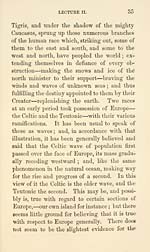Blair Collection > Celtic gleanings, or, Notices of the history and literature of the Scottish Gael
(48)
Download files
Complete book:
Individual page:
Thumbnail gallery: Grid view | List view

36 LECTURE 11.
existence of a Celtic population at any period
to the north of the Rhine. Let a Celtic scholar
take up a map, and cast his eye over the topo-
graphy of the north of Europe, and he will not
fall in with a single name of w^hich he can say,
with any degree of confidence, that it is derived
from the Celtic. In this he will observe a
striking contrast to the topography of southern
Europe. There almost every name of any anti-
quity is more or less Celtic in its conforma-
tion, and affords irrefragable evidence of the
early existence of a Celtic race. This is true
more especially of natural objects, which long-
est retain their original names. There is not
a fragment of the Celtic tongues to be traced in
such words as the " Vistula," the " Elbe," the
" Weser," the " Ems." How different from the
rivers of France and Italy we shall afterwards
see. If there ever was a Celtic race in northern
Europe, they have assuredly left no traces of
their existence, a circumstance hardly com-
patible with their existence at all. It has been
said, indeed, that the Cimbric Chersonesus —
the modern Jutland — gave origin to the Welsh
Cymri. The topography of Jutland affords no
evidence of this ; and, so far as its evidence
goes, would indicate that the Cimbric Cher-
sonesus of the Eomans was not the modern Jut-
existence of a Celtic population at any period
to the north of the Rhine. Let a Celtic scholar
take up a map, and cast his eye over the topo-
graphy of the north of Europe, and he will not
fall in with a single name of w^hich he can say,
with any degree of confidence, that it is derived
from the Celtic. In this he will observe a
striking contrast to the topography of southern
Europe. There almost every name of any anti-
quity is more or less Celtic in its conforma-
tion, and affords irrefragable evidence of the
early existence of a Celtic race. This is true
more especially of natural objects, which long-
est retain their original names. There is not
a fragment of the Celtic tongues to be traced in
such words as the " Vistula," the " Elbe," the
" Weser," the " Ems." How different from the
rivers of France and Italy we shall afterwards
see. If there ever was a Celtic race in northern
Europe, they have assuredly left no traces of
their existence, a circumstance hardly com-
patible with their existence at all. It has been
said, indeed, that the Cimbric Chersonesus —
the modern Jutland — gave origin to the Welsh
Cymri. The topography of Jutland affords no
evidence of this ; and, so far as its evidence
goes, would indicate that the Cimbric Cher-
sonesus of the Eomans was not the modern Jut-
Set display mode to: Large image | Transcription
Images and transcriptions on this page, including medium image downloads, may be used under the Creative Commons Attribution 4.0 International Licence unless otherwise stated. ![]()
| Early Gaelic Book Collections > Blair Collection > Celtic gleanings, or, Notices of the history and literature of the Scottish Gael > (48) |
|---|
| Permanent URL | https://digital.nls.uk/76269272 |
|---|
| Description | A selection of books from a collection of more than 500 titles, mostly on religious and literary topics. Also includes some material dealing with other Celtic languages and societies. Collection created towards the end of the 19th century by Lady Evelyn Stewart Murray. |
|---|
| Description | Selected items from five 'Special and Named Printed Collections'. Includes books in Gaelic and other Celtic languages, works about the Gaels, their languages, literature, culture and history. |
|---|

